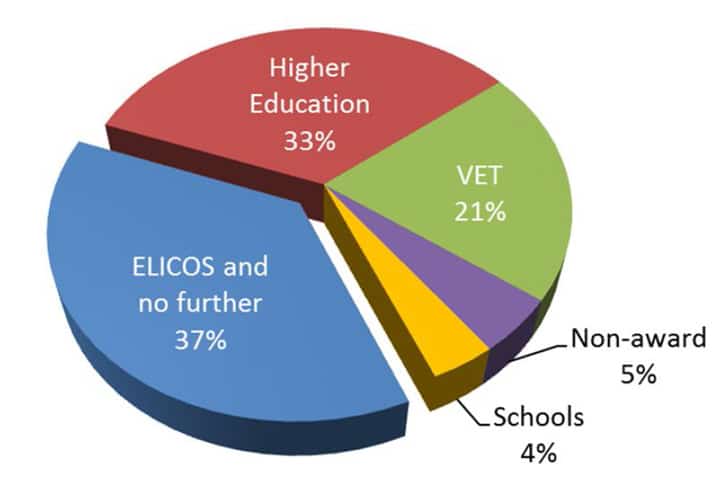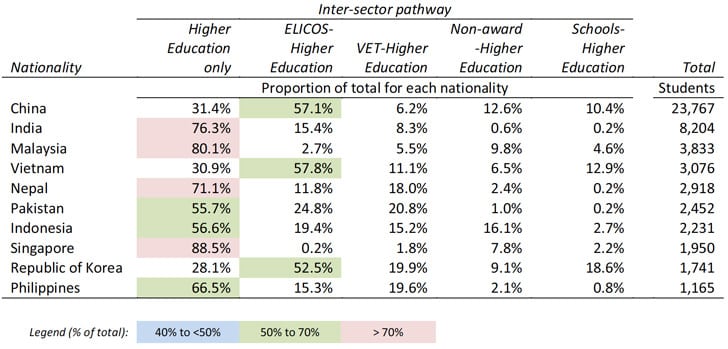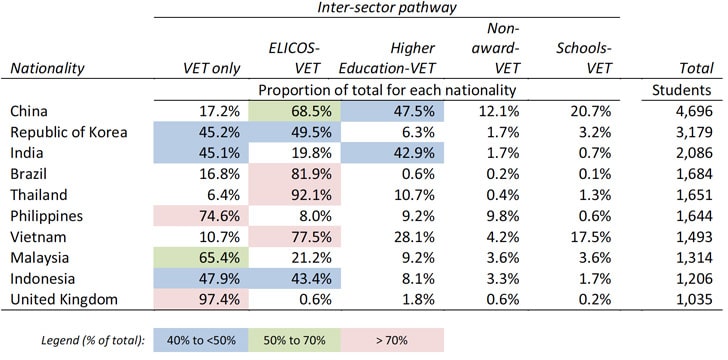Mapping student pathways from Australian language programmes
A new report from Australia’s Department of Education contains highly relevant information on the study pathways international students take in the Australian education system. The report reveals the results of an annual analysis of the sectors international students first choose when they come to Australia to study, and what happens once they complete this first course of study. It’s called Study pathways of international students in Australia, and it illuminates in particular how key the ELICOS (English Language Intensive Courses for Overseas Students) sector is to enrolments in Australia’s higher education sector, and to a smaller but still significant extent, its VET (Vocational Education and Training) sector. It also contains projections of what would happen to higher education and VET sectors if ELICOS enrolments were to increase – or to decrease. The report is based on four student cohorts:
- Student pathways of international students who completed ELICOS in 2012;
- Student pathways of international students who completed school in 2012;
- Student pathways of international students who commenced in higher education in 2013;
- Student pathways of international students who commenced in VET in 2013.
The insights into international students’ study pathways are especially interesting given the increasing competition Australia is facing in attracting international students. Asian institutions are quickly moving up world university rankings, and as they do, top Australian institutions are being bumped out of the coveted top 200 spots, as are leading institutions in other traditional destination markets. This article will focus primarily on the ELICOS sector as a first point of study for international students in Australia; please read the full report for an understanding of how Australia’s schools also feed into international enrolments in the VET and higher education sectors.
The main point
The first sentence of the report is worth dwelling on for a moment:
“In their Australian education experience, the majority of international students undertake study in more than one educational sector.”
This alone is enough to impress the value of Australia pursuing an international education strategy that considers – and supports – all sectors. It suggests a spectrum of international students coming into the country – students with different interests, goals, and educational and language backgrounds – and it underlines how important a good student experience in one sector is to the health of the others.
The highlights
- The ELICOS sector is the first study pathway point for two in every five international students in Australia’s tertiary sector.
- Almost two-thirds (63%) of international students who completed an ELICOS course in 2012 progressed to further study in another sector.
- Of the 63% who did progress, one-third (33%) moved directly into higher education, 21% moved straight to VET, and 9% went either to non-award programmes or schools.

The percentages of ELICOS students going on to other sectors are even greater when one considers international students who progress eventually, as opposed to immediately, to the other sectors. When these students are factored in, 36% of ELICOS students completing a course in 2012 ended up in higher education and 23% went on to VET institutes. Editor's note: The values shown here are consistent with those from an earlier AEI report which mapped student pathways based on 2010 data. For additional background on that previous report, please see our post "The link between student pathways and enrolment forecasts in Australia."
Some nationalities more likely than others to progress beyond ELICOS
Chinese and Vietnamese students are the most likely to stay in Australia for further study once they’ve completed an ELICOS course. Nearly three-quarters (72%) of Chinese ELICOS students went on to higher education in 2012, and over half of Vietnamese did (56%).
Indonesian and Thai students are the most likely to move from ELICOS to the VET sector. More than half (53%) of Indonesian students went on to VET from ELICOS courses, while 42% of Thai students did.
This might be a good time to point to recent growth trends of the top source countries for Australian institutions across all sectors, as of May 2014: China, India, Vietnam, Korea, and Malaysia.

An important channel for tertiary admissions
Overall, 36% of international students who commenced higher education studies in Australia in 2013 had studied previously in the country’s ELICOS sector (compared to 16% who had studied previously in VET or schools). Of international students in the higher education sector, those from Pakistan, Korea, and the Philippines were the most likely to have progressed from VET institutes. International students are much more likely to enroll directly into postgraduate courses from their countries (66.9%) without studying in other sectors first than are those studying in bachelor’s degrees. A much smaller proportion of 35% of international students commencing in bachelor’s degrees had not studied in other Australian education sectors. This suggests that ELICOS and other sectors are important funnels into undergraduate programmes in Australia.
ELICOS to VET
While 45% of international students commencing in Australian VET institutes in 2013 enrolled directly into their institutes, 36% had studied an ELICOS course right before commencing. In total (including more indirect study pathways), 46% of the international students commencing in Australian VET institutes in 2013 had studied an Australian ELICOS course – basically the same proportion that enrolled directly in VET without prior study in another Australian education sector. The international students more likely to go from Australian ELICOS to VET are from China, Korea, Brazil, Thailand, and Vietnam.
How increases and decreases in ELICOS enrolments would affect other sectors
The report includes fascinating analyses of what would happen to non-ELICOS sectors in the event of changes in the number of international students studying in ELICOS programmes in Australia. In one of these analyses, the base for the projection is the 47,330 international students who completed an ELICOS course in Australia for the first time in 2012. Just over 17,000 students (36%) progressed from ELICOS to higher education and 10,626 students (22.5%) progressed from ELICOS to VET. Using these numbers as a base, Australian Education International calculates that if 10% more international students completed ELICOS courses, higher education would gain 1,700 more international students and VET would gain 1,100. Conversely, if 10% fewer completed ELICOS programmes in Australia, higher education would lose 1,700 and VET would lose 1,000.
Other signs of ELICOS’s strategic importance
Another way to look at the dramatic importance of the ELICOS sector to other sectors is the following table, which looks at the study pathways of ten nationalities through the Australian education system. Note the huge percentages of Chinese, Korean, and Vietnamese students who come to higher education via ELICOS courses; all of these nationalities are in the top five source countries for Australian international student enrolments.


Australian ELICOS commencements are increasing
An English Australia news release notes that YTD May 2014 there were nearly 10,000 more students beginning ELICOS programmes compared to the same period for 2013, the best performance for the sector in many years. Industry insiders attribute some of this performance to the government’s extension of streamlined visa processing to some approved non-university institutions in late 2013. Coincidentally, the results of the 2014 Agent Barometer study show that agents (and students, by extension) report far fewer visa challenges in Australia this year than last year. For additional background, please see English Australia CEO Sue Blundell’s assessment of what the sector requires for sustained growth, as well as background on required visas for international students wanting to study English in Australia.
Linkages between sectors key to Australia’s competitiveness
Over the past decade, there have been long stretches of time where the Australian government prioritised the university sector to the neglect of other sectors, most dramatically VET and ELICOS. The Study pathways of international students in Australia report, and its striking opening fact that “the majority of international students undertake study in more than one educational sector” should highlight to all stakeholders that policies supporting all sectors – and all types of students – are crucial to boosting the likelihood that students will stay in Australia for longer periods of study, for different kinds of credentials, and at different types of institution.















